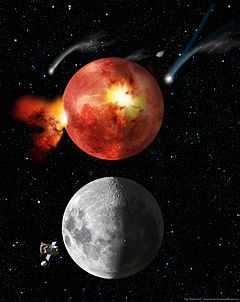
Back Groot Bombardement Afrikaans قصف شديد متأخر Arabic Gecikən ağır bombardman Azerbaijani Gran bombardeig tardà Catalan Pozdní velké bombardování Czech Det Store Bombardement Danish Spätes schweres Bombardement German Bombardeo intenso tardío Spanish Bonbardaketa Berantiar Handia Basque آخرین بمباران سنگین Persian


The Late Heavy Bombardment (LHB), or lunar cataclysm, is a hypothesized astronomical event thought to have occurred approximately 4.1 to 3.8 billion years (Ga) ago,[1] at a time corresponding to the Neohadean and Eoarchean eras on Earth. According to the hypothesis, during this interval, a disproportionately large number of asteroids and comets collided into the terrestrial planets and their natural satellites in the inner Solar System, including Mercury, Venus, Earth (and the Moon) and Mars.[2] These came from both post-accretion and planetary instability-driven populations of impactors.[3] Although it gained widespread credence,[4] definitive evidence remained elusive.[5] However, recent re-appraisal of the cosmo-chemical constraints suggest there was no late spike ("terminal cataclysm") in the bombardment rate.[6]
Evidence for the LHB derives from moon rock samples of Lunar craters brought back by the Apollo program astronauts. Isotopic dating showed that the rocks were last molten during impact events in a rather narrow interval of time, suggesting that a large proportion of craters were formed during this period. Several hypotheses attempt to explain this apparent spike in the flux of impactors in the inner Solar System, but no consensus yet exists. The Nice model, popular among planetary scientists, postulates that the giant planets underwent orbital migration, scattering objects from the asteroid belt, Kuiper belt, or both, into eccentric orbits, and into the path of the terrestrial planets.[3]
Other researchers doubt the heavy bombardment, arguing that the apparent clustering of lunar impact-melt ages is a statistical artifact produced by sampling rocks scattered from a single large impact.[1] They also note that the rate of impact cratering could differ significantly between the outer and inner zones of the Solar System.[7]
- ^ a b Cite error: The named reference
taylor1was invoked but never defined (see the help page). - ^ Claeys, Philippe; Morbidelli, Alessandro (1 January 2011). "Late Heavy Bombardment". In Gargaud, Muriel; Amils, Prof Ricardo; Quintanilla, José Cernicharo; Cleaves II, Henderson James (Jim); Irvine, William M.; Pinti, Prof Daniele L.; Viso, Michel (eds.). Encyclopedia of Astrobiology. Springer Berlin Heidelberg. pp. 909–912. doi:10.1007/978-3-642-11274-4_869. ISBN 978-3-642-11271-3.
- ^ a b Bottke, William F.; Norman, Marc D. (30 August 2017). "The Late Heavy Bombardment". Annual Review of Earth and Planetary Sciences. 45 (1): 619–647. Bibcode:2017AREPS..45..619B. doi:10.1146/annurev-earth-063016-020131. ISSN 0084-6597. Retrieved 11 August 2022.
- ^ Boehnke, Patrick; Harrison, T. Mark (27 September 2016). "Illusory Late Heavy Bombardments". Proceedings of the National Academy of Sciences. 113 (39): 10802–10806. Bibcode:2016PNAS..11310802B. doi:10.1073/pnas.1611535113. ISSN 0027-8424. PMC 5047187. PMID 27621460.
- ^ Mann, Adam (2018-01-24). "Bashing holes in the tale of Earth's troubled youth". Nature. 553 (7689): 393–395. Bibcode:2018Natur.553..393M. doi:10.1038/d41586-018-01074-6. PMID 29368708.
- ^ Zellner, Nicolle E. B. (September 2017). "Cataclysm No More: New Views on the Timing and Delivery of Lunar Impactors". Origins of Life and Evolution of Biospheres. 47 (3): 261–280. arXiv:1704.06694. Bibcode:2017OLEB...47..261Z. doi:10.1007/s11084-017-9536-3. ISSN 0169-6149. PMC 5602003. PMID 28470374.
- ^ Zahnle, K.; et al. (2003). "Cratering rates in the outer Solar System". Icarus. 163 (2): 263–289. Bibcode:2003Icar..163..263Z. CiteSeerX 10.1.1.520.2964. doi:10.1016/s0019-1035(03)00048-4.
© MMXXIII Rich X Search. We shall prevail. All rights reserved. Rich X Search